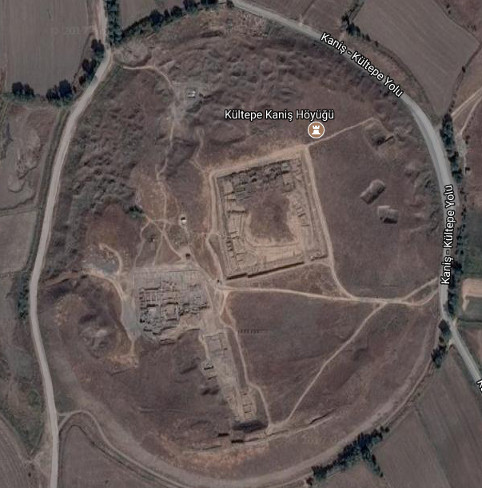Puzur-Aššur Dynasty
With the fall of the Ur III Empire and its hegemony over Aššur, the Assyrian city gained its independence and started growing politically and economically. This period known as the "Puzur-Aššur Dynasty" (after the family line of nine Assyrian rulers that was itself named after its eponymous founder Puzur-Aššur I), lasted nearly two hundred years and was brought to end when Samsī-Addu I [/riao/fromsamsiaddutomittanicilent18081364bc/samsiaddudynasty/samsiaddui/index.html] marched north from Babylonia and conquered Assyria.
Under the authority of these men, the city of Aššur, with its privileged geographical position linking southern Mesopotamia to Anatolia and Iran, and its principal trading colony in the Anatolian kārum of Kaneš became the economic centers of a complex trade network; for details, see the introductions to Ilu-šūma [/riao/fromcolonytocitystate23341809bc/puzurashurdynasty/ilushumma/index.html#Ilushumma_addurarum_trade], Erišum I [/riao/fromcolonytocitystate23341809bc/puzurashurdynasty/erishumi/index.html#Erishum1kanesh], Ikūnum [/riao/fromcolonytocitystate23341809bc/puzurashurdynasty/ikunum/index.html], and Sargon I [/riao/fromcolonytocitystate23341809bc/puzurashurdynasty/sargoni/index.html#Sargon_kanesh]). During this period, a number of important Assyrian institutions were established (e.g., the eponym-system, the governing body comprising the City Hall and the City Assembly, respectively bīt ālim and puḫrum) and the position of the ruler, including his close relationship to the divine, was further developed; see introductions to Ilu-šūma [/riao/fromcolonytocitystate23341809bc/puzurashurdynasty/ilushumma/index.html] and Erišum I [/riao/fromcolonytocitystate23341809bc/puzurashurdynasty/erishumi/index.html].

Satellite overview of the site of Kanesh (Kültepe Kaniş Hüyügü) (Google Maps, 2016).
Rulers (in chronological order):
Šalim-aḫum [/riao/fromcolonytocitystate23341809bc/puzurashurdynasty/shalimahum/index.html] (?-? BC)
Ilu-šūma [/riao/fromcolonytocitystate23341809bc/puzurashurdynasty/ilushumma/index.html] (?-1975? BC)
Erišum I [/riao/fromcolonytocitystate23341809bc/puzurashurdynasty/erishumi/index.html] (1974-1935 BC)
Ikūnum [/riao/fromcolonytocitystate23341809bc/puzurashurdynasty/ikunum/index.html] (1934-1921 BC)
Sargon I [/riao/fromcolonytocitystate23341809bc/puzurashurdynasty/sargoni/index.html] (1920-1881 BC)
Puzur-Aššur II [/riao/fromcolonytocitystate23341809bc/puzurashurdynasty/puzurashurii/index.html] (1880-1873 BC)
Narām-Sîn [/riao/fromcolonytocitystate23341809bc/puzurashurdynasty/naramsin/index.html] (1872-1829/19 BC)
Erišum II [/riao/fromcolonytocitystate23341809bc/puzurashurdynasty/erishumii/index.html] (1828/18-1809 BC)
In the Assyrian King List [/riao/kinglists/assyriankinglist/index.html] (AKL), the Puzur-Aššur Dynasty is divided into two parts [/riao/kinglists/assyriankinglist/assyriankinglist/index.html#Unknown eponymies]: (1) the period before Erišum I introduced the institution of the līmu [http://cdli.ox.ac.uk/wiki/doku.php?id=assyrian_eponyms_limmu] (the eponym-system) and (2) the period after it. The first three members of the dynasty (Puzur-Aššur I, Šalim-aḫum, and Ilu-šūma), together with three older (semi-)independent rulers of Aššur (Sulilu [/riao/fromcolonytocitystate23341809bc/sargonicanduriiiperiods/sulilu/index.html], Aminu [/riao/fromcolonytocitystate23341809bc/sargonicanduriiiperiods/aminu/index.html], and Kikkiya [/riao/fromcolonytocitystate23341809bc/sargonicanduriiiperiods/kikkiya/index.html]) belonged to the kings "[who(se names) appear on] bricks, (but) whose eponyms are not known." Starting with Erišum I, a man "[whose eponym]s (are known)," the AKL provides information on the filiation and the number of regnal years for each ruler; this is the standard format for the rest of that chronographic text. In addition, the AKL records that the Puzur-Aššur Dynasty came to an end when Samsī-Addu I [/riao/fromsamsiaddutomittanicilent18081364bc/samsiaddudynasty/samsiaddui/index.html] seized power:
Nathan Morello
Nathan Morello, 'Puzur-Aššur Dynasty', The Royal Inscriptions of Assyria online (RIAo) Project, The RIAo Project, a sub-project of MOCCI, 2021 [http://oracc.museum.upenn.edu/riao/fromcolonytocitystate23341809bc/puzurashurdynasty/]